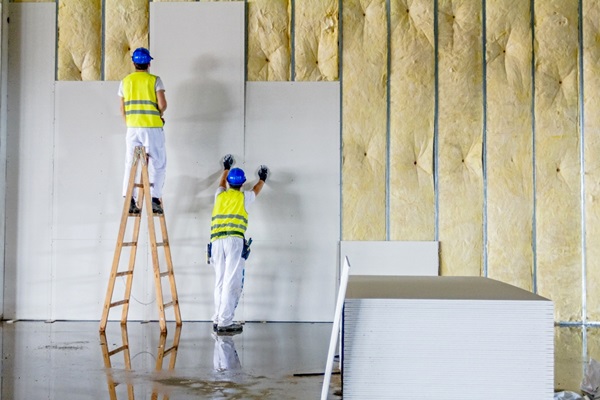Comprehensive Drywall Contractor Support for New Builds
Comprehensive Drywall Contractor Support for New Builds
Blog Article
Drywall Setup Made Easy: Tips for Perfect Results
Drywall installation is commonly perceived as an overwhelming task, yet with the appropriate method and expertise, it can become a workable endeavor. Grasping strategies for cutting, hanging, and completing drywall can significantly impact the result.
Picking the Right Materials
Choosing the ideal materials for drywall installation is vital to accomplishing a sturdy and aesthetically pleasing surface. drywall installation. The key component, drywall sheets, usually can be found in various thicknesses, with 1/2-inch sheets being common for indoor wall surfaces. For areas needing extra dampness resistance, such as washrooms or kitchens, take into consideration making use of green board or cement board, which are specially developed to stand up to moisture

Furthermore, selecting the best fasteners-- either screws or nails-- is essential for securing the drywall to the framework. Drywall screws are usually preferred for their holding power and minimized danger of popping. Lastly, take into consideration the complements such as guide and paint, which not only enhance the look yet likewise safeguard the drywall from moisture and wear.
Preparing the Installment Location
Before starting the drywall setup process, it is necessary to prepare the installment area thoroughly. This prep work includes several essential actions to guarantee a effective and smooth project. Clear the location of any type of furniture, home appliances, or obstructions that can hinder accessibility. A clean workspace decreases the danger of damages to existing items and permits for effective activity during setup.
Following, inspect the walls and ceiling for any kind of imperfections, such as fractures, openings, or mold. Address these problems ahead of time; spot any problems and permit sufficient time for fixings to dry. Furthermore, make certain that electrical outlets, switches, and plumbing are effectively placed and accounted for, as this will affect drywall positioning.
Think about the environmental conditions also. A steady temperature and humidity level are important for optimal adhesion and performance of the drywall materials. If necessary, use a dehumidifier or heater to develop ideal problems.
Cutting and Hanging Drywall
The key to reliable drywall installment hinges on the accurate cutting and hanging of the panels. Begin by measuring the room properly, taking right into account any type of obstructions such as electrical outlets or home windows. Utilize a straight edge and an utility blade to score the drywall along your measurements, after that break it along the scored line for a clean break. For even more complex cuts, such as around outlets, a drywall saw can be utilized for accuracy.

Constantly drywall fort worth work from the top down and entrusted to right, ensuring that you preserve a staggered pattern to boost stability. Effectively hanging the drywall sets the foundation for a smooth coating, ultimately causing premium cause your drywall job.
Insulation and Mudding Techniques
While appropriate cutting and dangling of drywall sets the stage, the next critical step includes understanding taping and mudding strategies to guarantee a smooth coating. have a peek at this website Insulation is important for strengthening joints and protecting against cracks; it involves embedding tape right into the used joint substance (mud) Beginning with a quality fiberglass or paper tape, applying the tape over the joint and pressing it into the wet mud utilizing a taping blade, making certain no air bubbles remain.
Once the tape is in place, apply a thin layer of joint compound over the tape, feathering the edges to produce a smooth shift to the drywall surface area. Permit this layer to completely dry entirely prior to sanding it gently to get rid of blemishes. Repeat this procedure, using added layers of mud as essential-- commonly two to 3 layers-- while progressively expanding the application location with each layer to attain a smooth appearance.
After the final coat dries, sand the surface with a fine-grit sandpaper until smooth. drywall repair. Keep in mind to wear a mask during fining sand to stay clear of Your Domain Name breathing in dirt bits. Mastering these taping and mudding techniques is critical for achieving a professional-quality coating in your drywall installment
Completing Touches for Perfection
Achieving a remarkable drywall installment goes past taping and mudding; it culminates in the ending up touches that boost the general appearance. These last actions are important in guaranteeing a professional-grade finish that boosts the looks of your area.
Begin by sanding the dried out joint substance to produce a smooth surface. Make use of a fine-grit sandpaper and a sanding block or pole sander for optimum control. Pay specific focus to edges and corners, as these locations often tend to call for even more precise work. After fining sand, wipe down the wall surfaces with a moist towel to eliminate any dirt particles, making certain a clean surface area for painting.
Next, apply a guide specifically created for drywall. This action is vital, as it aids seal the joint substance and gives an uniform base for the overcoat. As soon as the primer dries, evaluate for any flaws, and repair as needed.
Final Thought
In final thought, effective drywall setup pivots on the cautious choice of products, complete prep work of the installment location, and exact implementation of reducing and hanging methods. Proficiency of taping and mudding processes is vital for accomplishing a smooth surface.
Drywall setup is typically viewed as a complicated task, yet with the best method and understanding, it can become a manageable undertaking.Picking the ideal products for drywall setup is essential to achieving a durable and cosmetically pleasing surface.Before starting the drywall installment process, it is important to prepare the installation location completely. Mastering these taping and mudding techniques is essential for attaining a professional-quality surface in your drywall installation.
In verdict, successful drywall installation pivots on the mindful choice of materials, thorough prep work of the installation location, and exact execution of reducing and hanging techniques.
Report this page